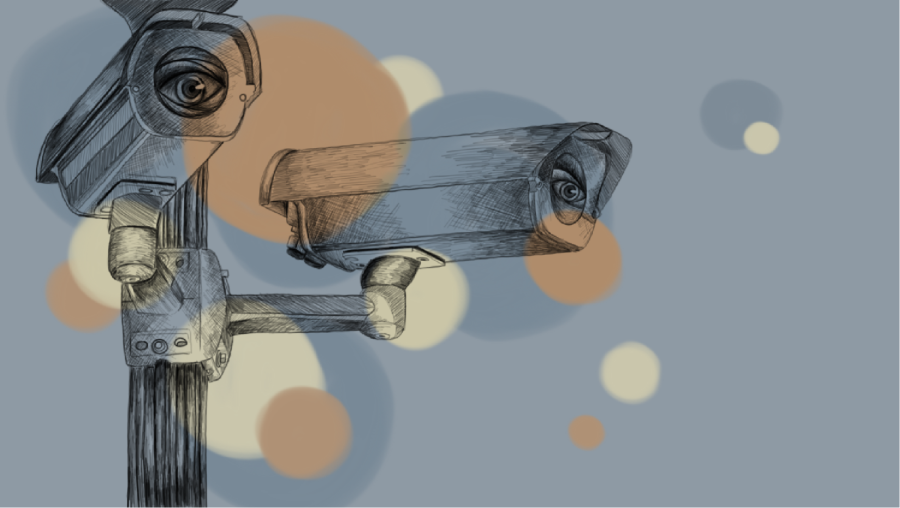Who is Watching U? The Increase of Video Surveillance on Campus
(Graphic by Storey McDonald | The Daily Utah Chronicle)
March 20, 2022
The University of Utah’s video surveillance system is expansive enough to cover a student living on campus the entire day — from leaving their dorm to the campus shuttles, outdoor areas and classrooms — there are cameras almost everywhere.
On the U’s main academic campus, located in Salt Lake City, there are 2,520 video cameras — 4,000 including the medical and research campuses.
According to Ryan Doyle, the director of security and law enforcement technology, the footage on these cameras is retained for 30 days. In case of an event, campus security and police can view the camera footage.
Before a new building can operate its video cameras or have a stand-alone camera placed, they must consult the Surveillance System Administrator Committee. In accordance with university policy 3-234, SSAC provides oversight for the “registration, approval, installation and operation of building access systems and other surveillance systems.”
SSAC is also the overseeing organization for operation, data collection, storage, disposal and access of the video footage. They also deal with privacy concern reports.
As of Jan. 9, 2022, commuter services did register their campus shuttle cameras with SSAC. Still unregistered, and not in use, are the video cameras in the new digital signs featured around campus.
“The new wayfinding signs on campus do support video surveillance,” Doyle said. “It was brought to our attention during installation that those cameras would be included. Right now, they are not currently active.”
They are not currently in use because SSAC is waiting on confirmation that they will be integrated into the campus surveillance system. Once confirmed, each camera will be subject to the SSAC approval process prior to being allowed to operate on campus.
There are cameras outdoors, as well in most common areas of buildings on campus. U Housing and Residential Education confirmed that all their housing buildings have video surveillance cameras in place, although they do not face dormitory doors where they could potentially see inside private living quarters.
Sierra Young, a third-year student at the U, has lived in student housing for a year and a half.
“I don’t necessarily feel safer because I doubt anyone is actually watching the cameras day and night, and the university has not established itself as a very good crime-fighting entity, but I am not necessarily uncomfortable by camera presence,” Young said.
Although there has not been a mass video camera installation on campus, there has been an increase in new buildings since the murder of ChenWei Guo near Red Butte Gardens in 2017 and the on-campus murder of Lauren McCluskey in 2018.
In data provided by Campus Safety magazine, 53% of institutions of higher education reported video surveillance provides evidence in investigations. 22% reported they aid in preventing crime.
“I can’t say what the university’s intentions are by increasing the amount of cameras, but I assume it is to make the students feel safer on campus in response to past violent events,” Young said. “I definitely think the cameras are insurance but I also think they are meant to create a perception of safety for students to feel better about being on campus.”
According to Rhombus Systems, the common drawbacks seen by schools installing video surveillance cameras include: teachers and students feeling mistrusted by their institution, cost and cameras not physically preventing crime.
For example, although there have been increasing amounts of cameras over the last few years, especially with multiple new buildings built, there were 69 bicycles stolen from campus in 2021. Most of these theft incidents were not able to be assisted with video surveillance.
Similarly, if someone is rear-ended on campus or involved in an accident, it may not be easy to obtain the footage of the accident despite being in a popular parking lot. Recorded criminal activity can be obtained through the UUPD or GRAMA requested.
Another form of investigative evidence is captured through the use of photographs by commuter services to target those parking in lots that require payment. Between the scanning of a license plate, the photographs with dates, times and locations, this is another way the U is tracking visitors’ whereabouts through visual surveillance.
Other relatively new video surveillance operations include the body cameras that UUPD officers started to wear last year. The officers are equipped with Axon body cameras that, according to Axon, have capabilities of “unlimited HD video, advanced audio, full-shift battery, pre-event buffer and LE-grade security.”
Each Axon body camera for police officers starts at $399, increasing to $699 depending on the generation of the device. Although that system is separate from the campus surveillance, any interaction with campus police could be subjected to that form of video recording.
According to Doyle, it is important to have video surveillance on campus because it may help dispatch police officers, which can be an important public safety tool.
“It is not worth violating federal or state law and it is important that we have an independent review body like SSAC to make sure video surveillance is not being used inappropriately,” Doyle said.









